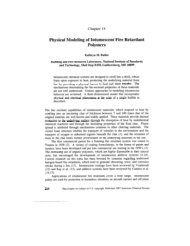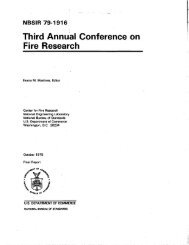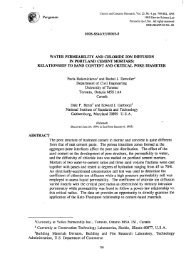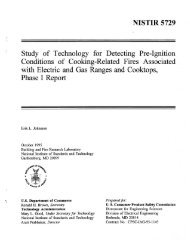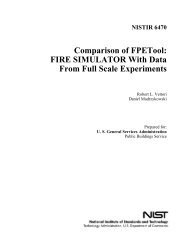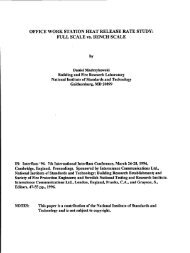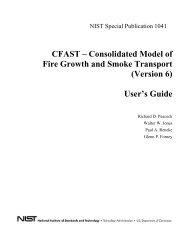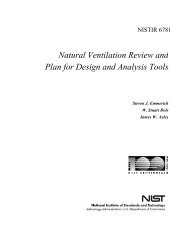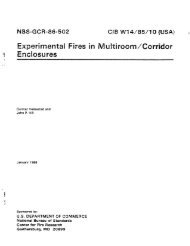Experimental transient performance of a heat pump equipped with a ...
Experimental transient performance of a heat pump equipped with a ...
Experimental transient performance of a heat pump equipped with a ...
Create successful ePaper yourself
Turn your PDF publications into a flip-book with our unique Google optimized e-Paper software.
Abstract<br />
<strong>Experimental</strong> <strong>transient</strong> <strong>performance</strong> <strong>of</strong> a <strong>heat</strong> <strong>pump</strong><br />
<strong>equipped</strong> <strong>with</strong> a distillation column<br />
James G. Gebbie a, *, Michael K. Jensen a , Piotr A. Domanski b,1<br />
a Department <strong>of</strong> Mechanical, Aerospace, and Nuclear Engineering, Rensselaer Polytechnic Institute, Troy, NY 12180-3590, USA<br />
b National Institute <strong>of</strong> Standards and Technology, Gaithersburg, MD 20899-8631, USA<br />
Received 12 September 2005; received in revised form 13 August 2006; accepted 15 August 2006<br />
Available online 11 December 2006<br />
A series <strong>of</strong> experiments were conducted on a <strong>heat</strong> <strong>pump</strong> <strong>equipped</strong> <strong>with</strong> a distillation column. The system was operated <strong>with</strong><br />
R32 and <strong>with</strong> a 30/70% by mass mixture <strong>of</strong> R32/134a to examine the difference between the <strong>transient</strong> <strong>performance</strong> trends <strong>with</strong><br />
a pure fluid (R32), and those <strong>with</strong> a zeotropic mixture (R32/134a). Additionally, the effects <strong>of</strong> varying <strong>heat</strong> transfer fluid mass<br />
flow, compressor speed, and accumulator sump <strong>heat</strong> input were examined. Each test was 1 h in duration. The <strong>heat</strong> <strong>pump</strong> capacities<br />
did not generally achieve steady state during the R32/134a tests. Steady state was generally achieved during the R32 tests.<br />
As a percentage <strong>of</strong> the final (end-<strong>of</strong>-test) capacity, the rate <strong>of</strong> capacity increase was greater during the R32/134a tests than during<br />
those conducted <strong>with</strong> the pure fluid. The R32/134a tests exhibited capacity oscillations early in each <strong>transient</strong> that were not present<br />
during the R32 tests. The results show that circulating refrigerant mass and composition are the primary controlling factors<br />
<strong>with</strong> regard to <strong>transient</strong> capacity.<br />
Ó 2006 Elsevier Ltd and IIR. All rights reserved.<br />
Keywords: Heat <strong>pump</strong>; Experiment; Refrigerant; R32; Binary mixture; R134a; Transient; Distillation; Performance<br />
Performance transitoire expérimentale d’une pompe à chaleur<br />
munie d’une colonne de distillation<br />
Mots clés : Pompe à chaleur ; Expérimentation ; Frigorigène ; R32 ; Mélange binaire ; R134a ; Régime transitoire ; Distillation ; Performance<br />
1. Introduction<br />
The steady-state measure <strong>of</strong> how well a <strong>heat</strong> <strong>pump</strong><br />
utilizes electrical energy input to <strong>heat</strong> or cool an occupied<br />
* Corresponding author. 1675 John R Road, Rochester Hills, MI<br />
48307, USA. Tel.: þ1 248 650 1130.<br />
E-mail address: jggebbie@comcast.net (J.G. Gebbie).<br />
1 Member <strong>of</strong> IIR Commission B1.<br />
0140-7007/$35.00 Ó 2006 Elsevier Ltd and IIR. All rights reserved.<br />
doi:10.1016/j.ijrefrig.2006.08.014<br />
International Journal <strong>of</strong> Refrigeration 30 (2007) 499e505<br />
space is the coefficient <strong>of</strong> <strong>performance</strong> (COP). In <strong>heat</strong>ing<br />
mode, this is typically calculated from<br />
COP ¼ _qcd<br />
_wcp<br />
www.elsevier.com/locate/ijrefrig<br />
ð1Þ<br />
But COP is only a partial indication <strong>of</strong> the overall <strong>performance</strong><br />
<strong>of</strong> a <strong>heat</strong> <strong>pump</strong>. Over the course <strong>of</strong> a season, <strong>heat</strong><br />
<strong>pump</strong>s cycle on and <strong>of</strong>f numerous times. Better insight to<br />
the impact <strong>of</strong> cycling on a customer’s electrical consumption
500 J.G. Gebbie et al. / International Journal <strong>of</strong> Refrigeration 30 (2007) 499e505<br />
Nomenclature<br />
COP Coefficient <strong>of</strong> <strong>performance</strong><br />
cpf Constant pressure specific <strong>heat</strong> <strong>of</strong> the <strong>heat</strong><br />
transfer fluid [J kg 1 C 1 ]<br />
HSPF Heating seasonal <strong>performance</strong> factor<br />
[Btu W 1 h 1 HTF<br />
]<br />
Heat transfer fluid<br />
_mf Heat transfer fluid mass flow rate [kg s 1 ]<br />
Heat transfer fluid mass flow rate through the<br />
_mfcd<br />
_mfev<br />
condenser [kg s 1 ]<br />
Heat transfer fluid mass flow rate through the<br />
evaporator [kg s 1 ]<br />
is gained by evaluating the <strong>heat</strong>ing seasonal <strong>performance</strong><br />
factor (HSPF).<br />
HSPF ¼ Seasonal building <strong>heat</strong> load ðBtu h 1Þ ð2Þ<br />
Seasonal power input ðWÞ<br />
HSPF is calculated using a procedure established by the<br />
National Institute <strong>of</strong> Standards and Technology [1].<br />
Generally, the HSPF calculation procedure requires experimental<br />
<strong>heat</strong> <strong>pump</strong> startup/shutdown testing to determine<br />
the expected cyclic losses in terms <strong>of</strong> a ‘‘cyclic degradation<br />
coefficient,’’ which is then included in the HSPF calculation.<br />
The HSPF calculation procedure also allows the use <strong>of</strong> a default<br />
degradation coefficient that represents an experiencebased<br />
estimate <strong>of</strong> the aggregate effects <strong>of</strong> cycling. The value<br />
<strong>of</strong> the default degradation factor was established using R22,<br />
a single component refrigerant, and was designed to be<br />
conservative.<br />
Mulroy and Didion [2] showed that cyclic losses are<br />
largely attributable to the lack <strong>of</strong> circulating charge during<br />
startup. In fixed area expansion device systems, the refrigerant<br />
migrates to the accumulator during the <strong>of</strong>f-cycle, and the<br />
time required to reach maximum <strong>performance</strong> depends on<br />
how long it takes the refrigerant to re-establish its steadystate<br />
distribution throughout the system.<br />
Because <strong>of</strong> the lack <strong>of</strong> single component direct R22 replacements,<br />
refrigerant mixtures have received attention as<br />
alternatives in <strong>heat</strong> <strong>pump</strong>s. Zeotropic refrigerant mixtures,<br />
in particular, present certain thermodynamic advantages<br />
over pure fluids. Mulroy et al. [3] and Domanski et al. [4]<br />
showed that the average temperature differences between<br />
the <strong>heat</strong> transfer fluid (HTF) and the refrigerant in counterflow<br />
condensers and evaporators can be reduced when using<br />
zeotropic mixtures. This leads to reduced irreversibilities<br />
and, therefore, improved COP. Additionally, Cooper and<br />
Borchardt [5] and Gromoll and Gutbier [6] showed that zeotropic<br />
mixtures could be used to modulate <strong>heat</strong> <strong>pump</strong> capacity<br />
by varying the volatility <strong>of</strong> the circulating refrigerant.<br />
Furthermore, Rothfleisch [7] demonstrated that capacity<br />
modulation could be passive. Rothfleisch conducted<br />
_q Rate <strong>of</strong> <strong>heat</strong> transfer (<strong>heat</strong> exchanger capacity)<br />
[W]<br />
_qcd Rate <strong>of</strong> <strong>heat</strong> output from the condenser [W]<br />
_qsp Rate <strong>of</strong> <strong>heat</strong> input to the sump [W]<br />
rpmcp Compressor speed [rpm]<br />
tcp Compressor drive shaft torque [N m]<br />
Tfin Heat transfer fluid inlet temperature [ C]<br />
Tfout Heat transfer fluid outlet temperature [ C]<br />
Compressor power [W]<br />
_wcp<br />
experiments using a zeotropic mixture in a system <strong>equipped</strong><br />
<strong>with</strong> a fixed area expansion device in <strong>heat</strong>ing mode. As the<br />
outdoor temperature decreased, more and more refrigerant<br />
was stored in the accumulator. Due to vaporeliquid equilibrium,<br />
this caused the circulating composition to become<br />
richer in the more volatile component. As a result, the <strong>heat</strong>ing<br />
capacity decrease associated <strong>with</strong> decreasing outdoor<br />
temperature was attenuated. Rothfleisch also incorporated<br />
a <strong>heat</strong>er and distillation column to enhance the composition<br />
shift further.<br />
Because <strong>of</strong> the impact <strong>of</strong> circulating composition on<br />
steady-state <strong>performance</strong>, it is reasonable to expect that <strong>transient</strong><br />
changes in circulating refrigerant composition also<br />
would affect <strong>transient</strong> <strong>performance</strong>. As is the case for circulating<br />
mass [2], this should have an impact on the HSPF cyclic<br />
degradation factor. However, no experimental work was<br />
found in the open literature comparing <strong>transient</strong> <strong>heat</strong> <strong>pump</strong><br />
characteristics when charged <strong>with</strong> zeotropic mixtures <strong>with</strong><br />
the characteristics when charged <strong>with</strong> a pure refrigerant.<br />
Also, no work examining <strong>heat</strong> <strong>pump</strong> <strong>transient</strong> behavior<br />
due to changing circulating composition was found.<br />
The goal <strong>of</strong> the present investigation was to experimentally<br />
examine the <strong>transient</strong> characteristics <strong>of</strong> a <strong>heat</strong> <strong>pump</strong><br />
<strong>equipped</strong> <strong>with</strong> a distillation column charged <strong>with</strong> a single<br />
component refrigerant and <strong>with</strong> a zeotropic mixture (R32<br />
and R32/134a, respectively). The experiments were conducted<br />
using variations in four design parameters.<br />
2. <strong>Experimental</strong> apparatus and procedures<br />
The distillation <strong>heat</strong> <strong>pump</strong> consisted <strong>of</strong> a refrigerant<br />
loop and two watereethylene glycol HTF loops (Fig. 1). A<br />
variable-speed reciprocating compressor <strong>pump</strong>ed the refrigerant<br />
through the condenser and evaporator, which were<br />
counterflow <strong>heat</strong> exchangers composed <strong>of</strong> annular tubes.<br />
The <strong>heat</strong> exchangers were <strong>of</strong> the same design as those described<br />
by Kedzierski and Kim [8,9]. The expansion device<br />
was a needle valve. A distillation column, refrigerant storage<br />
accumulator (sump), and electrical <strong>heat</strong> source were
Distillation<br />
Column<br />
Gage Glass<br />
J.G. Gebbie et al. / International Journal <strong>of</strong> Refrigeration 30 (2007) 499e505<br />
Compressor<br />
Expansion<br />
Device<br />
Condenser<br />
Evaporator<br />
Accumulator / Sump<br />
<strong>with</strong> Electric Heater<br />
Electric<br />
Variable<br />
Heater<br />
Electric<br />
Variable<br />
Heater<br />
incorporated into the refrigerant loop in the manner<br />
described by Rothfleisch [7]; the distillation column design<br />
details may be found in Ref. [7]. The distillation accumulator<br />
sump level was monitored <strong>with</strong> a gage-glass. An electric<br />
cartridge <strong>heat</strong>er was mounted in the bottom <strong>of</strong> the sump.<br />
Ten sampling ports were located on the compressor discharge<br />
line. Samples were drawn from this location to ensure<br />
that the refrigerant was a single-phase vapor, as required for<br />
sample analysis by gas chromatography.<br />
A turbine <strong>pump</strong> provided flow through each HTF loop and<br />
flow rates were measured using Coriolis effect flowmeters.<br />
HTF inlet temperatures to the condenser and evaporator<br />
were controlled by overcooling, using chilled water in the<br />
condenser HTF loop and a chiller unit in the evaporator<br />
loop, then re-<strong>heat</strong>ing using variable electric immersion<br />
<strong>heat</strong>ers.<br />
Temperature measurements throughout the system were<br />
made using type-T thermocouples. Thermopiles, consisting<br />
<strong>of</strong> 10 type-T thermocouples immersed directly in the HTF,<br />
were used to measure sensible <strong>heat</strong> change across the <strong>heat</strong><br />
exchangers.<br />
A full factorial design experiment [10] <strong>with</strong> four factors<br />
and two levels per factor was used for both tested fluids (R32<br />
and R32/134a). The four independent variables tested were:<br />
sump <strong>heat</strong>er input power, evaporator HTF mass flow rate,<br />
condenser HTF mass flow rate, and compressor speed. The<br />
HTF<br />
Cooler<br />
Chilled Water<br />
Mass<br />
Flow<br />
Meter<br />
Mass<br />
Flow<br />
Meter<br />
Refrigerated<br />
HTF<br />
Chiller<br />
Fig. 1. <strong>Experimental</strong> distillation <strong>heat</strong> <strong>pump</strong>.<br />
Condenser<br />
HTF<br />
Pump<br />
Expansion<br />
Tanks<br />
Evaporator<br />
HTF<br />
Pump<br />
501<br />
low/high sump <strong>heat</strong>er power, condenser and evaporator<br />
HTF mass flows, and compressor speed settings were 25/<br />
100 W, 0.08/0.16 kg/s and 800/1000 rpm, respectively. The<br />
values <strong>of</strong> these settings were chosen as a result <strong>of</strong> preliminary<br />
system tests using R134a [11].<br />
All tests were performed at a low evaporator HTF inlet<br />
temperature <strong>heat</strong>ing condition, a moderate room ambient<br />
condenser HTF inlet temperature, and <strong>with</strong> the same charged<br />
mass <strong>of</strong> R32. The nominal evaporator HTF inlet temperature,<br />
condenser HTF inlet temperature, and R32 charge<br />
were 7 C, 20 C, and 1500 g, respectively.<br />
Prior to each <strong>transient</strong> test, the experimental system was<br />
placed in a repeatable initial condition as follows. The <strong>heat</strong><br />
<strong>pump</strong> was operated at each factorial condition to be tested<br />
until the capacity and sump level were relatively steady.<br />
The refrigerant loop was then shutdown, but the HTF flow<br />
rates and inlet temperatures were kept constant through<br />
the condenser and evaporator. Then, the compressor was intermittently<br />
‘‘jogged’’ to <strong>pump</strong> as much liquid refrigerant as<br />
possible to the sump. This procedure was judged [12] to give<br />
repeatable <strong>transient</strong> results. Each test was run for 1 h.<br />
Some <strong>of</strong> the data were read directly from the instrumentation<br />
used (sump <strong>heat</strong>er power, sump liquid level, and compressor<br />
speed), while others required supplemental<br />
calculations. Details can be found in the work <strong>of</strong> Gebbie<br />
[12].
502 J.G. Gebbie et al. / International Journal <strong>of</strong> Refrigeration 30 (2007) 499e505<br />
A thermal conductivity type gas chromatograph (GC)<br />
was used to determine the mass fractions <strong>of</strong> the constituents<br />
in the refrigerant samples. During each test, visual sump<br />
gage-glass observations were made and refrigerant samples<br />
were taken approximately every 10 min.<br />
With the torque and speed <strong>of</strong> the compressor shaft available<br />
from the transducer data, compressor power was<br />
calculated using<br />
_wcp ¼ tcp$rpm cp<br />
60<br />
ð3Þ<br />
The <strong>heat</strong> exchanger capacity calculations were based on<br />
the sensible <strong>heat</strong> change and mass flow <strong>of</strong> the HTF.<br />
_q ¼ _mfcpf Tfout Tfin ð4Þ<br />
The RMS uncertainty [13] and experimental repeatability<br />
<strong>of</strong> the data were examined. These evaluations were<br />
made based on the state <strong>of</strong> the system at the completion <strong>of</strong><br />
each test. The uncertainties were: condenser and evaporator<br />
capacities, and compressor power, 1.5%; R32 mass fraction<br />
in an R32/134a mixture, 0.5% by mass R32. The experimental<br />
repeatability in condenser capacity, compressor<br />
power, and COP were 1%, and the repeatability in evaporator<br />
capacity was 2.5%.<br />
The uncertainty <strong>of</strong> the independent variables ð_qsp;<br />
_mfcd ; _mfev ; and rpm cpÞ were: sump <strong>heat</strong>er power, 0.5%;<br />
HTF flow rates for both <strong>heat</strong> exchangers, 0.15%; HTF inlet<br />
temperatures, 1 C. The compressor speed data were considered<br />
to be exact because the readings were derived<br />
directly from a rotation counter. The repeatability <strong>of</strong> the independent<br />
variables were: sump <strong>heat</strong>er power, 9% at 25 W<br />
and 5% at 100 W; condenser HTF mass flow, 1.5%;<br />
evaporator HTF mass flow, 6%; compressor speed,<br />
2.5%. Details <strong>of</strong> the RMS analysis and experimental uncertainty<br />
determination, as well as a more detailed description<br />
<strong>of</strong> the experimental apparatus and procedures, can be<br />
found in the work <strong>of</strong> Gebbie [12].<br />
3. Results<br />
Transient results for each fluid were compared by plotting<br />
the condenser capacity, evaporator capacity, sump level,<br />
and, in the case <strong>of</strong> the mixture tests, circulating R32 concentration<br />
as a function <strong>of</strong> time. Comparisons were made for<br />
each parametric variation.<br />
An example <strong>of</strong> the pure R32 condenser capacity, evaporator<br />
capacity, and sump level <strong>transient</strong> behavior changes due<br />
to increased sump <strong>heat</strong>er power <strong>with</strong> pure R32 is shown in<br />
Fig. 2. Increasing sump <strong>heat</strong>er power decreased the time<br />
needed for the <strong>heat</strong> <strong>pump</strong> to reach steady state. The test performed<br />
at a sump <strong>heat</strong>er power <strong>of</strong> 25 W required more than<br />
the 1 h test time to achieve steady condenser capacity and<br />
sump level. The evaporator capacity during that test was nearly<br />
steady after 30 min. The test that was performed at a sump<br />
<strong>heat</strong>er power <strong>of</strong> 100 W required approximately 28 min,<br />
35 min, and 20 min to achieve steady condenser capacity,<br />
sump level, and evaporator capacity, respectively. These results<br />
are consistent <strong>with</strong> those <strong>of</strong> Mulroy and Didion [2] showing<br />
that the overall system <strong>transient</strong> is controlled by the time<br />
necessary to introduce refrigerant from the sump into circulation.<br />
Furthermore, the results suggest that the majority <strong>of</strong> the<br />
refrigerant will be held-up in the condenser. Fig. 2 shows<br />
that, during the low sump <strong>heat</strong>er power test, only the condenser<br />
capacity and sump level are changing after 30 min. Thus, the<br />
energy and mass transfer is exclusively between the sump<br />
and the condenser.<br />
Comparison <strong>of</strong> the results from all <strong>of</strong> the pure R32 tests<br />
can be summarized as follows [12]:<br />
1. The early (
q (W)<br />
condenser capacity<br />
evaporator capacity<br />
Fig. 4 shows that the sump level during the low sump<br />
<strong>heat</strong>er power test was nearly steady after approximately<br />
2 min. However, these data were based on visual observations<br />
<strong>of</strong> the sump gage-glass. It seems likely, in light <strong>of</strong> the decreasing<br />
R32 concentration (Fig. 3) that refrigerant from the sump<br />
was being added to circulation. Gage-glass observations<br />
made during the high sump <strong>heat</strong>er power test showed the<br />
sump level to be steady after approximately 20 min.<br />
Except for early <strong>transient</strong> oscillations, <strong>with</strong>in the first<br />
10 min, Fig. 3 shows that the evaporator and condenser capacities<br />
increased throughout the high and low sump <strong>heat</strong>er<br />
power tests. The rate <strong>of</strong> capacity increase during the low<br />
sump <strong>heat</strong>er power tests was small and probably due to the<br />
addition <strong>of</strong> refrigerant as suggested above. The capacity<br />
q (W)<br />
condenser capacity<br />
evaporator capacity<br />
2750<br />
2500<br />
2250<br />
2000<br />
1750<br />
1500<br />
1250<br />
1000<br />
750<br />
500<br />
250<br />
0<br />
-250<br />
-500<br />
-750<br />
-1000<br />
-1250<br />
-1500<br />
-1750<br />
-2000<br />
0 10 20 30 40 50 60<br />
time (minutes)<br />
2750<br />
2500<br />
2250<br />
2000<br />
1750<br />
1500<br />
1250<br />
1000<br />
750<br />
500<br />
250<br />
0<br />
-250<br />
-500<br />
-750<br />
-1000<br />
-1250<br />
-1500<br />
-1750<br />
-2000<br />
J.G. Gebbie et al. / International Journal <strong>of</strong> Refrigeration 30 (2007) 499e505<br />
0 10 20 30 40 50 60<br />
time (minutes)<br />
increase during the high sump <strong>heat</strong>er power test was due<br />
to the increase in the circulating R32 concentration.<br />
Comparison <strong>of</strong> the results from all <strong>of</strong> the zeotropic R32/<br />
134a mixture tests can be summarized as follows [12]:<br />
1. The capacity data showed an oscillatory character early<br />
in the <strong>transient</strong>s. This suggests that the distillation <strong>heat</strong><br />
<strong>pump</strong> was a second-order system (or higher).<br />
2. Steady-state was not generally achieved during the<br />
R32/134a tests. This was due to continuing changes<br />
in circulating mass and/or circulating composition<br />
that persisted until the end <strong>of</strong> each 1 h.<br />
3. Due to test procedures, the R32 mass fraction circulating<br />
through the <strong>heat</strong> <strong>pump</strong> just after startup was<br />
100<br />
Fig. 3. Transient capacity and R32 mass fraction: R32/134a example.<br />
7<br />
6<br />
5<br />
4<br />
3<br />
2<br />
1<br />
0<br />
90<br />
80<br />
70<br />
60<br />
50<br />
Sump level (cm)<br />
Fig. 2. Transient capacity and sump level: R32 example.<br />
% R32<br />
experimental conditions<br />
.<br />
qsp .<br />
mfev .<br />
mfcd : 25 W<br />
: 0.16 kg/s<br />
: 0.16 kg/s<br />
and<br />
capacity<br />
sump level<br />
rpmcp : 1000 rpm<br />
.<br />
qsp .<br />
mfev .<br />
mfcd : 100 W<br />
: 0.16 kg/s<br />
: 0.16 kg/s<br />
and<br />
capacity<br />
sump level<br />
rpmcp : 1000 rpm<br />
experimental conditions<br />
.<br />
qsp .<br />
mfev .<br />
mfcd : 25 W<br />
: 0.16 kg/s<br />
: 0.08 kg/s<br />
and<br />
capacity<br />
% R32<br />
rpmcp : 800 rpm<br />
.<br />
qsp .<br />
mfev .<br />
mfcd : 100 W<br />
: 0.16 kg/s<br />
: 0.08 kg/s<br />
and<br />
capacity<br />
% R32<br />
rpmcp : 800 rpm<br />
503
504 J.G. Gebbie et al. / International Journal <strong>of</strong> Refrigeration 30 (2007) 499e505<br />
sump level (cm)<br />
25<br />
20<br />
15<br />
10<br />
5<br />
0<br />
experimental . conditions<br />
qsp : 25 W<br />
.<br />
m<br />
. fev<br />
: 0.16 kg/s<br />
mfcd : 0.08 kg/s<br />
rpmcp : 800 rpm<br />
.<br />
qsp : 100 W<br />
.<br />
m<br />
. fev : 0.16 kg/s<br />
mfcd : 0.08 kg/s<br />
rpmcp : 800 rpm<br />
0 10 20 30 40 50 60<br />
time (minutes)<br />
Fig. 4. Transient sump level: R32/134a example.<br />
significantly higher than expected. The R32 mass fraction<br />
decreased rapidly due to refrigerant flashing in the<br />
sump.<br />
4. Increasing sump <strong>heat</strong>er power<br />
a. Had little effect on the time required for the rate <strong>of</strong><br />
capacity increase to become linear (10 min in the<br />
case <strong>of</strong> the tests shown in Fig. 3).<br />
b. Caused the evaporator outlet to become two phase<br />
during the test duration. The resultant liquid<br />
down-flow in the distillation column, combined<br />
<strong>with</strong> the vapor up-flow, caused an increase in circulating<br />
R32 composition.<br />
5. Increasing evaporator HTF flow rate<br />
a. Caused a slight increase in the early <strong>transient</strong> capacity<br />
gradient in the evaporator<br />
b. Had no apparent effect on the condenser capacity<br />
<strong>transient</strong>.<br />
c. Had no consistent effect on the <strong>transient</strong> sump level<br />
or circulating composition data.<br />
6. Increasing condenser HTF flow rate increased the amplitude<br />
but decreased the frequency <strong>of</strong> early <strong>transient</strong><br />
condenser capacity oscillations.<br />
7. Increasing compressor speed<br />
a. Had no substantial effect on the <strong>transient</strong> capacity<br />
data.<br />
b. Increased the rate <strong>of</strong> sump level decrease, and the<br />
time necessary for the sump to reach its steady level.<br />
c. Delayed the point in the <strong>transient</strong> where composition<br />
shifting began.<br />
8. Overall, the mixture results indicate that, shortly after<br />
startup, <strong>transient</strong> <strong>heat</strong> exchanger capacities were a function<br />
<strong>of</strong> circulating mass and composition alone. This<br />
conclusion is based on the data that showed<br />
a. The time dependence <strong>of</strong> the capacity was limited to<br />
the time dependence <strong>of</strong> the composition in those<br />
cases when the circulating mass was steady.<br />
b. The time dependence <strong>of</strong> the capacity was limited to<br />
the time dependence <strong>of</strong> the circulating mass in<br />
high-side pressure (kPa)<br />
250<br />
240<br />
230<br />
220<br />
210<br />
200<br />
190<br />
180<br />
170<br />
160<br />
150<br />
140<br />
130<br />
120<br />
110<br />
100<br />
90<br />
0 10 20 30 40 50 60<br />
time (minutes)<br />
experimental conditions<br />
.<br />
qsp : 25 W<br />
.<br />
m<br />
. fev<br />
: 0.16 kg/s<br />
mfcd : 0.08 kg/s<br />
rpmcp : 800 rpm<br />
.<br />
qsp : 100 W<br />
.<br />
m<br />
. fev : 0.16 kg/s<br />
mfcd : 0.08 kg/s<br />
rpmcp : 800 rpm<br />
Fig. 5. Transient high-side pressures: R32/134a example.<br />
those cases when the circulating composition was<br />
steady.<br />
The clearest difference between the pure R32 tests and<br />
the R32/134a mixture tests is that there were capacity oscillations<br />
present during the R32/134a tests. The capacity rise<br />
during the pure fluid tests was nearly monotonic.<br />
The reason for the capacity oscillations during the mixture<br />
tests is thought to have been due to the rapid addition<br />
<strong>of</strong> R134a at the beginning <strong>of</strong> the <strong>transient</strong>s. The data show<br />
(Fig. 3) that the capacity oscillations were generally restricted<br />
to the period <strong>of</strong> rapidly decreasing R32 concentration.<br />
During this time, the pressure on the high-side <strong>of</strong> the<br />
refrigerant loop was rising rapidly (Fig. 5). Had the R32 concentration<br />
remained constant, the pressure would have continued<br />
increasing. However, the rapid addition <strong>of</strong> R134a<br />
<strong>with</strong> its lower volatility (low vapor pressure) tended to decrease<br />
the pressure. During the early <strong>transient</strong>, the increasing<br />
concentration <strong>of</strong> R134a was occasionally enough to dominate,<br />
and decrease, the high-side pressure (Fig. 5). Subsequently,<br />
the R134a condensed and the pressure began to<br />
rise again, which increased the R32 vapor concentration in<br />
the condenser. These pressure oscillations caused changes<br />
in the saturation temperature in the two-phase region <strong>of</strong><br />
the condenser, and this caused the refrigerant-to-HTF<br />
temperature difference and, thus, the condenser capacity,<br />
to oscillate. High-side pressure/capacity oscillations were<br />
responsible for oscillations in the evaporator due to the coupling<br />
<strong>of</strong> the high and low sides.<br />
The data also show that startup <strong>transient</strong>s <strong>with</strong> refrigerant<br />
mixtures may generally be shorter than those <strong>with</strong> pure<br />
fluids. The low sump <strong>heat</strong>er power test shown in Fig. 3 is<br />
nearly steady after 10 min. It would appear that, had it not<br />
been for the distillation column, the high sump <strong>heat</strong>er power<br />
test would have been steady after approximately 15 min.<br />
The pure fluid tests took substantially longer to reach steady<br />
state (Fig. 2). The difference was because <strong>of</strong> the capacity<br />
‘‘boost’’ given to the mixture tests by the high R32
concentration at the start (Fig. 3). Although the steady-state<br />
capacities <strong>of</strong> the mixture tests were less than those <strong>of</strong> the<br />
pure fluid, they seem to reach steady state more quickly. If<br />
the HSPF degradation was determined following the procedure<br />
by Parken et al. [1], then the impact <strong>of</strong> cycling might be<br />
substantially less for a mixture.<br />
4. Conclusions<br />
An experimental investigation was conducted into the effects<br />
<strong>of</strong> using either a zeotropic refrigerant mixture (30/70%<br />
by mass R32/134a) or a pure fluid (R32) on the <strong>transient</strong> <strong>performance</strong><br />
<strong>of</strong> a <strong>heat</strong> <strong>pump</strong>. Due to its potential for enhancing<br />
capacity modulation when a <strong>heat</strong> <strong>pump</strong> is charged <strong>with</strong> a<br />
zeotropic mixture, a distillation column was installed in<br />
the manner prescribed by Rothfleisch [7].<br />
Sixteen experiments were performed using pure R32,<br />
and sixteen were performed using an R32/134a mixture.<br />
Each set <strong>of</strong> sixteen experiments consisted <strong>of</strong> a 2 4 factorial<br />
design in which the factors were sump <strong>heat</strong>er power, evaporator<br />
HTF mass flow rate, condenser HTF mass flow rate,<br />
and compressor speed.<br />
In general, the pure R32 experiments achieved steady<br />
state during the 1 h allotted for each test; <strong>of</strong>ten, the R32/<br />
134a mixture tests did not. This was due to the time necessary<br />
for the distillation column to separate R32 from<br />
R134a during the mixture tests. The <strong>transient</strong> R32/134a mixture<br />
experiments showed distinct, repeatable, oscillations<br />
during startup. These oscillations, not present during the<br />
pure R32 experiments, were hypothesised as being due to<br />
the rapid addition <strong>of</strong> R134a to circulation early in the <strong>transient</strong>s.<br />
The mixture tests received a capacity boost due to<br />
the relatively high R32 concentration at the start <strong>of</strong> each<br />
test. As a result, the mixture tests operated closer to the<br />
steady-state capacity for more <strong>of</strong> the test duration than the<br />
pure fluid tests. This means that <strong>heat</strong> <strong>pump</strong>s operating<br />
<strong>with</strong> mixtures may have significantly less cyclic degradation.<br />
Therefore, the default cyclic degradation coefficient<br />
<strong>of</strong> Parken et al. [1] may excessively penalize such systems.<br />
Acknowledgments<br />
J.G. Gebbie et al. / International Journal <strong>of</strong> Refrigeration 30 (2007) 499e505<br />
The National Institute <strong>of</strong> Standards and Technology<br />
(NIST) sponsored this research as part <strong>of</strong> its continuing efforts<br />
to work <strong>with</strong> industry and improve energy utilization.<br />
Their financial support, in addition to their facilities and<br />
expertise, is gratefully acknowledged.<br />
References<br />
505<br />
[1] W.H. Parken, G.E. Kelly, D.A. Didion, Method <strong>of</strong> Testing,<br />
Rating and Estimating the Heating Seasonal Performance <strong>of</strong><br />
Heat Pumps NBSIR 80-2002, National Institute <strong>of</strong> Standards<br />
and Technology, Gaithersburg, MD, 1980.<br />
[2] W.J. Mulroy, D.A. Didion, A Laboratory Investigation <strong>of</strong><br />
Refrigerant Migration in a Split Unit Air Conditioner NBSIR<br />
83-2756, National Institute <strong>of</strong> Standards and Technology,<br />
Gaithersburg, MD, 1983.<br />
[3] W.J. Mulroy, P.A. Domanski, D.A. Didion, Glide matching<br />
<strong>with</strong> binary and ternary zeotropic refrigerant mixtures Part 1.<br />
An experimental study, International Journal <strong>of</strong> Refrigeration<br />
17 (4) (1994) 220e225.<br />
[4] P.A. Domanski, W.J. Mulroy, D.A. Didion, Glide matching<br />
<strong>with</strong> binary and ternary zeotropic refrigerant mixtures Part 2.<br />
A computer simulation, International Journal <strong>of</strong> Refrigeration<br />
17 (4) (1994) 226e230.<br />
[5] W.D. Cooper, H.J. Borchardt, The use <strong>of</strong> refrigerant mixtures<br />
in air-to-air <strong>heat</strong> <strong>pump</strong>s, in: Proceedings <strong>of</strong> the XVth International<br />
Congress <strong>of</strong> Refrigeration, vol. 4, 1979, pp. 995e1001.<br />
[6] B. Gromoll, H. Gutbier, Continuous control <strong>of</strong> the <strong>heat</strong>ing capacity<br />
<strong>of</strong> <strong>heat</strong> <strong>pump</strong>s by means <strong>of</strong> non-azeotropic mixtures,<br />
in: Proceedings <strong>of</strong> Commision E2 <strong>of</strong> the International Institute<br />
<strong>of</strong> Refrigeration, Trondheim, Norway, 1985, pp. 257e263.<br />
[7] P.I. Rothfleisch, A Simple Method <strong>of</strong> Composition Shifting<br />
<strong>with</strong> a Distillation Column for a Heat Pump Employing a Zeotropic<br />
Refrigerant Mixture NISTIR 5689, National Institute <strong>of</strong><br />
Standards and Technology, Gaithersburg, MD, 1995.<br />
[8] M.A. Kedzierski, M.S. Kim, Single-phase Heat Transfer and<br />
Pressure Drop Characteristics <strong>of</strong> an Integral-spine-fin <strong>with</strong>in<br />
an Annulus NISTIR 5454, National Institute <strong>of</strong> Standards<br />
and Technology, Gaithersburg, MD, 1994.<br />
[9] M.A. Kedzierski, M.S. Kim, Convective Boiling and Condensation<br />
Heat Transfer <strong>with</strong> a Twisted-tape Insert for R12, R22,<br />
R152a, R134a, R290, R32/R134a, R32/152a, R290/R134a,<br />
R134a/R600a NISTIR 5905, National Institute <strong>of</strong> Standards<br />
and Technology, Gaithersburg, MD, 1997.<br />
[10] L. Ott, An Introduction to Statistical Methods and Data Analysis,<br />
PWS-Kent Publishing Co., Boston, MA, 1988.<br />
[11] J.G. Gebbie, M.K. Jensen, Development and Verification <strong>of</strong><br />
a Simulation Model <strong>of</strong> a Zeotropic Refrigerant Mixture Heat<br />
Pump <strong>with</strong> a Distillation Column Progress Report prepared under<br />
NIST purchase order #43NANB714532, National Institute<br />
<strong>of</strong> Standards and Technology, Gaithersburg, MD, 1998.<br />
[12] J.G. Gebbie, Pure fluid and binary mixture <strong>transient</strong>s <strong>of</strong> a <strong>heat</strong><br />
<strong>pump</strong> <strong>equipped</strong> <strong>with</strong> a distillation column: an experimental<br />
and numerical investigation, PhD thesis, Rensselaer Polytechnic<br />
Institute, Troy, NY, 2002.<br />
[13] R.J. M<strong>of</strong>fat, Describing the uncertainties in experimental<br />
results, <strong>Experimental</strong> Thermal and Fluid Sciences 1 (1)<br />
(1988) 3e17.



